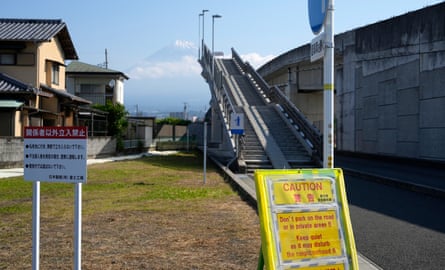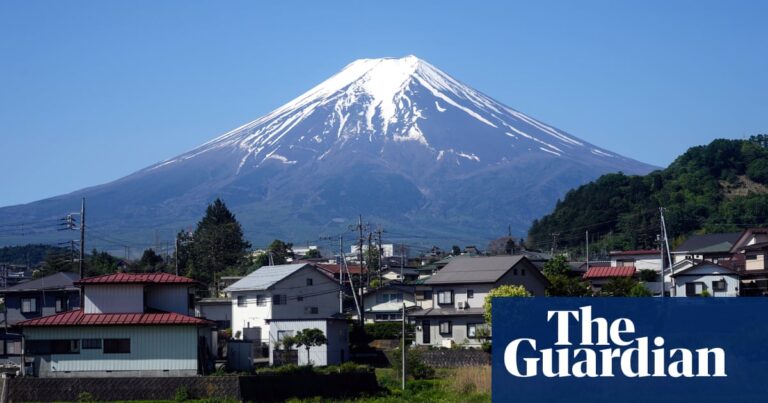Centuries later, the majestic mountain continues to captivate people, as Japanese artist Katsushika Hokusai created his famous woodblock series “Thirty-six Views of Mount Fuji,” but now tourists are in record numbers, eager to commemorate their visit with carefully staged photographs.
An unobstructed view of Mount Fuji is a rare treat. A property developer agreed this week to demolish a nearly completed apartment building in western Tokyo because it blocked residents’ views of the mountain. Developer Sekisui House said it decided to demolish the 10-story building because it “did not fully consider the impact on the landscape.”
The mountain’s popularity has also caused problems in other parts of Japan, where authorities outraged by throngs of unruly foreign tourists have erected huge fences blocking views of popular photo spots.
What is Mount Fuji and where is it located?
Mount Fuji, an active volcano that last erupted in 1707 and rises 3,776 metres above sea level, is Japan’s, and perhaps the world’s, best known mountain. Its conical outline, which straddles Shizuoka and Yamanashi prefectures, and its unique place in the hearts of the Japanese people are the reasons for this. Mount Fuji is a site of religious pilgrimage, an omen of good fortune, and has inspired countless artists and writers. Visible from Tokyo on a clear day, it’s no coincidence that the mountain featured prominently in the opening ceremonies of the 2019 Rugby World Cup and the 2020 Tokyo Olympics.
Why has it become a must-see destination for tourists?
 A warning sign has been installed near Mount Fuji’s Yume-no-Ohashi Bridge amid a series of complaints about overcrowding. Photo: Franck Robichon/EPA
A warning sign has been installed near Mount Fuji’s Yume-no-Ohashi Bridge amid a series of complaints about overcrowding. Photo: Franck Robichon/EPA
Its popularity is the logical result of a surge in tourism to Japan since the country lifted travel restrictions following the COVID-19 pandemic. Buoyed by the weak yen and Japan’s reputation for safety, hospitality and good food, more than three million people visited the country in March and April. The full-year figure is expected to smash the previous record of 31.9 million set in 2019. Not visiting Mount Fuji on a trip to Japan is like not seeing the pyramids on a trip to Egypt. Mount Fuji can be seen and photographed long enough from the Shinkansen, but many tourists want to get closer for the perfect holiday memory.
Why is the town blocking popular views of Mount Fuji?
 Mount Fuji can be seen through a hole in a black screen installed opposite a convenience store in the town of Fujikawaguchiko. Photo: Ajizono Manami/AP
Mount Fuji can be seen through a hole in a black screen installed opposite a convenience store in the town of Fujikawaguchiko. Photo: Ajizono Manami/AP
Mount Fuji, a UNESCO World Heritage Site, has become a target for tourists looking to take the quintessential Japanese photo for social media. So this month, screen doors were installed in the town of Fujikawaguchiko to try to stop throngs of tourists trying to snap photos of the mountain towering in the distance with another Japanese icon in the foreground: the Lawson convenience store. But the measure, introduced after complaints that tourists were littering, trespassing and breaking traffic rules, has had mixed results. Within days, holes big enough to fit a smartphone camera lens began appearing in the screen doors. There are plans to install new barriers made of sturdier material. Authorities in a nearby town say they will install tall metal fences by the end of this month after smartphone-toting tourists strayed onto a busy road to take photos from the Mount Fuji Dream Bridge.
What measures have authorities taken to address overcrowding on the mountain itself?
Anyone wanting to climb to the summit of Mount Fuji, or at least one of its higher peaks, will soon have to book in advance and pay a 2,000 yen (10 pounds) fee. The measure applies to the popular Yoshida route to the mountain and comes into effect at the start of the climbing season in July. Authorities hope the fee will ease concerns about overcrowding and littering, and discourage “bullet climbs” – where inexperienced and inappropriately dressed climbers start their ascent at night to watch the sunrise, then descend without taking proper rest. To ease congestion, entry to the route will be limited to 4,000 people a day, and climbing will not be allowed between 4pm and 3am.

